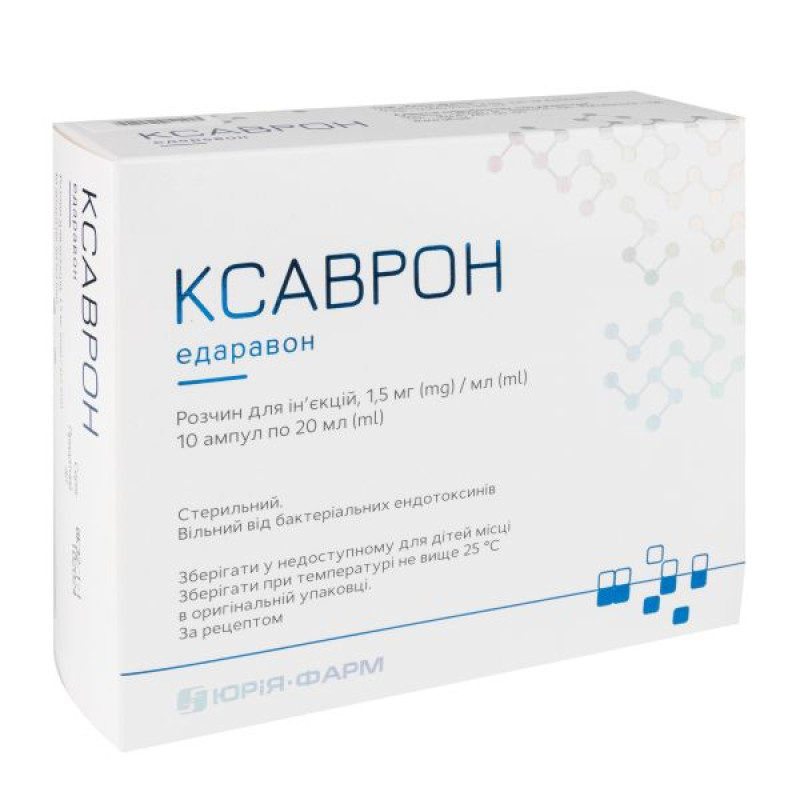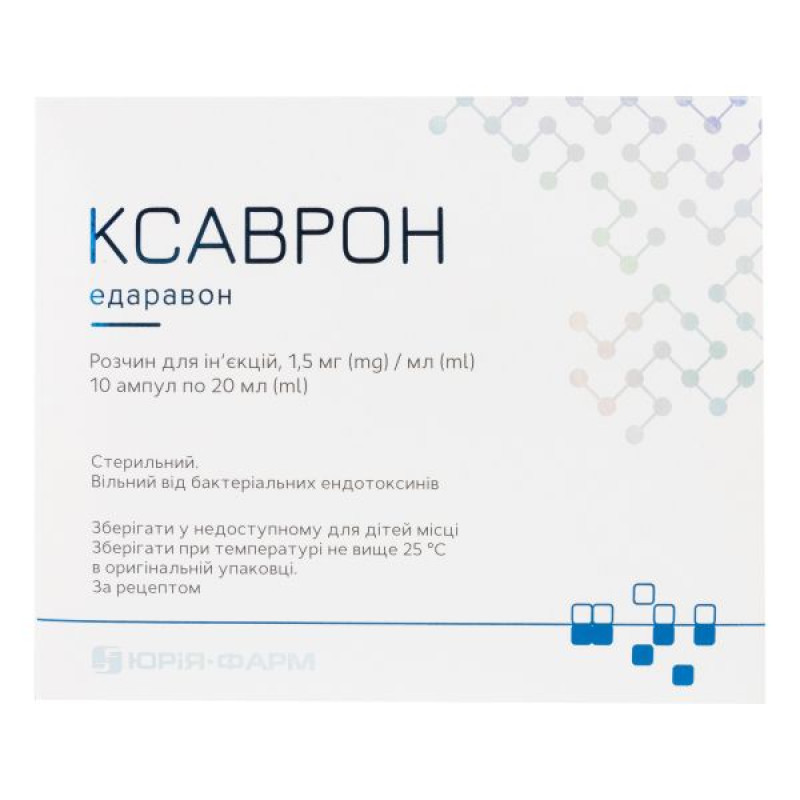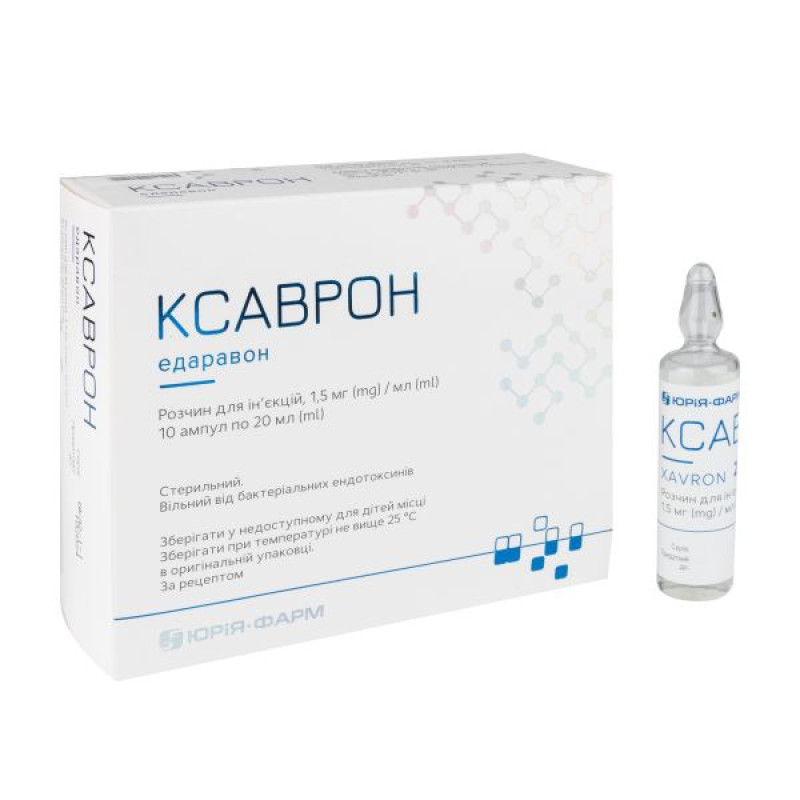Xavron solution for injection 1.5 mg/ml ampoule 20 ml No. 10

Instructions for use Xavron solution for injection 1.5 mg/ml ampoule 20 ml No. 10
Composition
active ingredient: edaravone;
1 ml of solution contains 1.5 mg of edaravone;
Excipients: sodium metabisulfite (E 223), sodium chloride, sodium hydroxide, phosphoric acid, water for injections.
Dosage form
Solution for injection.
Main physicochemical properties: clear colorless or slightly yellowish liquid.
Pharmacotherapeutic group
Other agents acting on the nervous system. Edaravone.
ATX code N07XX14.
Pharmacological properties
Pharmacodynamics
Free radicals, such as hydroxyl radicals (OH), are one of the main factors in vascular disorders in the brain associated with ischemia; in ischemia or hemorrhage, at the time of restoration of patency due to an abnormal increase in the production of arachidonic acid, the amount of free radicals produced increases. These free radicals cause peroxidation of unsaturated fatty acids, which are part of the lipids of cell membranes, damaging them, leading to impaired brain function.
In the acute stage of ischemic cerebral infarction, the drug demonstrates a protective effect, inhibiting the onset and development of ischemic cerebrovascular disorders, such as cerebral edema, neurological symptoms, and slow neuronal death.
The etiology of the onset and progression of amyotrophic lateral sclerosis (ALS) is currently not fully understood. However, it has been suggested that oxidative stress caused by free radicals may be an etiological factor for this pathology. Edaravone, due to its inhibitory effect on lipid peroxidation by binding free radicals, has been shown to inhibit the progression of the disease by reducing oxidative damage to brain cells (vascular endothelial cells/nerve cells).
Pharmacokinetics
The pharmacokinetics of the drug were studied in five healthy male volunteers and five healthy elderly male volunteers 30 minutes after multiple intravenous doses of the drug (0.5 mg/kg) twice daily for 2 days. The concentration of unchanged drug in the blood plasma in both groups decreased equally without any evidence of accumulation.
| Pharmacokinetic parameters | Healthy male volunteers (n = 5) | Healthy elderly male volunteers (n = 5) |
| C max (ng/ml) | 888 ± 171 | 1041 ± 106 |
| t ½ α (g) | 0.27 ± 0.11 | 0.17 ± 0.03 |
| t ½ β (g) | 2.27 ± 0.80 | 1.84 ± 0.17 |
The level of binding of edaravone to serum proteins and serum albumin is 92% and 89–91%, respectively (in vitro).
In plasma, the main metabolites of edaravone are sulfate conjugates, and glucuronic acid conjugates have also been detected. In urine, glucuronides and, to a lesser extent, sulfates have been detected.
12 hours after administration, 0.7–0.9% of the drug is excreted in the urine as unchanged drug, and 71.0–79.9% as metabolites.
Indication
Relief of neurological symptoms, manifestations of impairments in activities of daily living and functional disorders associated with acute ischemic stroke.
Slowing the progression of functional disorders in patients with amyotrophic lateral sclerosis.
Contraindication
Severe renal failure.
Hypersensitivity to the components of the drug.
Interaction with other medicinal products and other types of interactions
With the simultaneous use of edaravone and antibiotics with a renal excretion type (cefazolin sodium, cefotiam hydrochloride, piperacillin sodium, etc.), there is a possibility of increased renal dysfunction. In the case of such combined use, careful supervision with monitoring of renal function is required.
Xavron should be dissolved in 100 ml of physiological sodium chloride solution before administration. Mixing with other intravenous solutions containing various sugars may result in decreased edaravone concentrations.
The drug should not be mixed with parenteral nutrition solutions and/or solutions containing amino acids, and should not be administered through the same infusion systems.
Xavron should not be mixed with anticonvulsants, including diazepam, phenytoin sodium, etc., due to the possibility of turbidity. Also, do not mix with potassium canrenoate.
Application features
The use of the drug Xavron should be carried out under the close supervision of doctors who have experience in the use of this drug.
During therapy, worsening of acute renal failure or renal dysfunction, severe hepatic dysfunction and/or disseminated intravascular coagulation (DIC), which may be fatal, may occur.
Cases of recurrent cerebral embolism or cerebral hemorrhage have been reported during or after administration of the medicinal product.
At the beginning of treatment with the drug, blood urea nitrogen (BUN), creatinine, aspartate aminotransferase (AST), alanine aminotransferase (ALT), lactate dehydrogenase (LDH), creatine kinase, erythrocytes, kidney function test and platelet analysis should be determined.
During administration of edaravone, liver function tests, kidney function tests and blood tests should be performed regularly, and if abnormal changes in test results or oliguria are detected, the drug should be discontinued immediately and appropriate measures should be taken. In addition, close monitoring of the patient's condition should continue after the end of the injections.
Patients with amyotrophic lateral sclerosis (ALS) are likely to experience a decrease in serum creatinine levels due to muscle atrophy as the disease progresses, so instead of comparing a single serum creatinine level with a control value, the change in serum creatinine levels should be monitored to determine whether or not there is a trend toward worsening.
In addition, since the ASA value varies depending on the amount of water in the body, instead of comparing a single ASA value with a control value, the change in ASA should be monitored to see whether or not there is a trend toward deterioration.
In patients with muscle atrophy, in addition to measuring serum creatinine and AST, renal function should be assessed by tests that are independent of changes in muscle mass, such as determination of estimated glomerular filtration rate, serum cystatin C, and calculation of urinary creatinine clearance, before and during injections.
If renal dysfunction occurs during injection, the administration of the medicinal product should be stopped immediately and appropriate measures should be taken in collaboration with physicians who have sufficient knowledge and experience in the treatment of renal dysfunction.
If complications such as infection occur during the injection and additional antibiotics are required, the need for continued injection of the drug should be carefully considered, and if continued, laboratory parameters should be monitored particularly closely. In addition, even after the end of the drug administration, a detailed examination and careful observation should be carried out (for more details, see section "Interaction with other medicinal products and other types of interactions").
Since fever, cough, shortness of breath and acute pulmonary dysfunction accompanied by chest X-ray abnormalities may occur during treatment with the drug, the patient's condition should be carefully monitored, and if such symptoms appear, the drug should be discontinued and appropriate measures should be taken, such as the administration of adrenal corticosteroids.
Elderly patients require particularly careful monitoring, as many fatalities have been observed among patients in this category.
Xavron should be used with caution in the following categories of patients:
with impaired renal function and/or dehydration (due to high risk of developing acute renal failure);
with infection (renal failure may worsen due to deterioration of the patient's general condition);
with impaired liver function (possible worsening of liver failure);
with heart disease (possible worsening of the disease, as well as the development of renal failure);
with severe impairment of consciousness (patients do not respond to external stimulation);
elderly patients (fatal cases have been reported in this category of patients).
Use during pregnancy or breastfeeding
The safety of the drug during pregnancy has not been established. It is not advisable to prescribe the drug to pregnant women.
Women should refrain from breastfeeding while using the drug, as the drug passes into breast milk.
Ability to influence reaction speed when driving vehicles or other mechanisms
The drug is intended for use in a hospital setting, therefore such data are not available.
Method of administration and doses
Inhibitory effect on the progression of dysfunction in amyotrophic lateral sclerosis (ALS): administer 60 mg of edaravone (2 ampoules) by intravenous infusion over 60 minutes, once a day. Before administration, the contents of the ampoule should be dissolved in a sufficient volume of 0.9% sodium chloride. As a rule, the period of administration of the drug and the rest period in total are 28 days and are considered as one course, such courses are repeated. The first course consists of 14 days of taking the drug, followed by a 14-day break and rest, the second course and subsequent courses consist of 10 days of administration of the drug for 14 days, after which a 14-day rest period begins.
In patients with acute ischemic stroke, the duration of therapy may be shortened, depending on the clinical condition of the patient.
Elderly patients.
Since elderly patients generally have reduced physiological functions, if side effects occur, the drug should be discontinued and appropriate measures should be taken. There is extensive published evidence that elderly patients often have fatal outcomes, so monitoring should be particularly careful.
Children
The safety of the drug for children has not been established.
There is insufficient experience of use in acute ischemic stroke in children; there is no clinical experience of use in children with ALS.
Overdose
Cases of overdose have not been described.
Side effects
From the urinary system: acute renal failure, nephrotic syndrome.
Skin: rash, redness, swelling, itching, erythema.
From the hepatobiliary system: liver dysfunction, liver failure, fulminant hepatitis, jaundice.
From the nervous system: insomnia, headache.
Cardiovascular system: increased blood pressure.
On the part of the blood: agranulocytosis, DIC syndrome (disseminated intravascular coagulation), decreased red blood cell count, leukocytosis, leukopenia, decreased hematocrit, decreased hemoglobin, thrombocytosis, thrombocytopenia.
Respiratory: Acute lung injury syndrome, accompanied by pyrexia, cough, dyspnea, chest X-ray abnormalities.
Gastrointestinal: nausea, vomiting.
Musculoskeletal system: rhabdomyolysis.
On the part of the immune system: shock, anaphylaxis (urticaria, decreased blood pressure, difficulty breathing, etc.).
Changes in laboratory parameters: increased levels of ALT, AST, LDH, ɣ-glutamyl transpeptidase, alkaline phosphatase, bilirubin, creatinine, uric acid in serum, glycosuria, hematuria, proteinuria.
Changes at the injection site: redness at the injection site, swelling at the injection site.
General disorders: hyperthermia.
Reporting of adverse reactions
Reporting adverse reactions after registration of a medicinal product is important. This allows monitoring of the benefit/risk ratio of the medicinal product. Medical and pharmaceutical professionals, as well as patients or their legal representatives, should report all cases of suspected adverse reactions and lack of efficacy of the medicinal product via the Automated Information System for Pharmacovigilance at the following link: https://aisf.dec.gov.ua
Expiration date
2 years.
Storage conditions
Store at a temperature not exceeding 25 °C in the original packaging.
Keep out of reach of children.
Incompatibility
Do not mix with other medicinal products except those mentioned in the section "Method of administration and dosage".
Packaging
Glass ampoules of 20 ml.
2 ampoules in a contour blister pack, 1 contour blister pack in a cardboard pack.
5 ampoules in a contour blister pack, 2 contour blister packs in a cardboard pack.
Vacation category
According to the recipe.
Producer
LLC "Yuria-Pharm".
Location of the manufacturer and address of its place of business.
Ukraine, 18030, Cherkasy region, Cherkasy city, Kobzarska st., 108. Tel.: (044) 281-01-01.
There are no reviews for this product.
There are no reviews for this product, be the first to leave your review.
No questions about this product, be the first and ask your question.









